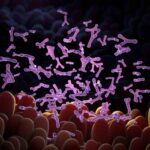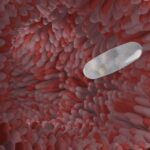• Altering gene expression
• Obesity link
What is already known on this topic
Circadian rhythm—the process that regulates the sleep-wake cycle—is influenced by many factors, including the gut microbiota. But little is known about the mechanisms by which gut microbes regulate mammalian metabolism and daily rhythms.What this research adds
Researchers found that some gut bacteria regulate the daily rhythms of metabolic gene expression by altering histone acetylation, a key circadian-epigenetic mechanism. In epithelial cells of the small intestine of mice, the microbiota initiated the expression of the histone deacetylase 3 (HDAC3) enzyme, which led to synchronized daily oscillations in the expression of metabolic genes related to nutrient transport and lipid metabolism. Disrupting the circadian light cycle and the expression of HDAC3 worsened diet-induced obesity.Conclusions
The study shows that altering circadian rhythms of mice affects their metabolism and increases the risk for metabolic disorders. The findings suggest a potential link between microbiota disruptions and human obesity.
Gut microbes influence daily rhythms by synchronizing oscillations in the expression of genes related to nutrient transport and lipid metabolism, a mouse study shows.
The results, published in Science, identify a key mechanism by which gut microbes control host metabolism, and show how altering the microbiota could increase the risk for metabolic disorders.
For a long time, scientists have known that circadian rhythm—the process that regulates the sleep-wake cycle—is influenced by many factors, including the gut microbiota. But little is understood about the mechanisms by which gut bacteria regulate mammalian metabolism and daily rhythms.
Altering gene expression
Because a key mechanism by which circadian cycles generate rhythms in metabolic gene expression is through histone acetylation of chromatin, Zheng Kuang and his colleagues at the University of Texas Southwestern Medical Center set out to investigate whether the microbiota regulates host circadian gene expression through histone modifications.
By analyzing epithelial cells in the small intestine of mice, the researchers found that certain bacteria initiated the expression of the histone deacetylase 3 (HDAC3) enzyme, which led to synchronized daily oscillations in the expression of metabolic genes related to nutrient transport and lipid metabolism.
On the other hand, germ-free mice, which lacked a gut microbiota, didn’t show this rhythmic regulation of their metabolism.
Obesity link
Disrupting the circadian light cycle and the expression of HDAC3 worsened diet-induced obesity. And mice that lacked the Hdac3 gene in the gut epithelium were protected from diet-induced obesity, glucose intolerance, and fatty liver.
Although it’s unclear how the gut microbiota regulates HDAC3 in the gut epithelium, the findings suggest that altering the cross-talk between the circadian clock and the gut microbiota could promote metabolic dysfunction and obesity in people.











